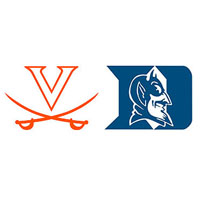
But Salt, the sixth-best defensive player in the ACC, according to Basketball-Reference.com, will be a key for the second-ranked ‘Hoos if they are to pull the road upset over #4 Duke and its star, Bagley, on Saturday, for roughly 20 minutes or so, anyway.
Salt, a 6’10” redshirt junior, and Isaiah Wilkins, a 6’7” senior, will draw the bulk of the minutes against Bagley, a 6’11” freshman, and 6’10” Duke freshman Wendell Carter, and most certainly the most important minutes on the defensive end for Virginia will come from Salt and Wilkins, the nation’s best-rated defender.
The first focal point for UVA in its Pack-Line defense will be the post-to-post doubles that coach Tony Bennett uses to force the ball out of the post. Most teams, when doubling a post scorer, use the player, usually a guard, defending the offensive player on the perimeter who passes the ball into the post, to double-team, which does two things. One, the double involves a post defender and a perimeter defender who is smaller, usually leaving the post player on offense with some daylight to see over at least part of the double team. And then two, there’s an immediate getaway option, in the form of the perimeter offensive player left open by the double-team.
The post-to-post double still leaves an offensive player open, but it’s not a perimeter guy. Rather, it’s the other post guy, who ideally, from the offensive perspective, cuts hard to the rim to offer the doubled teammate a quick escape option.
The hard part is the second defender is the other post defender, not a guard, so you’re talking, say, the 6’7 Wilkins, 6’7” freshman De’Andre Hunter, 6’9” redshirt sophomore Mamadi Diakite, the 6’10” Salt.
And it’s not like the post player cutting to the rim is left to his own devices. The Pack-Line covers the second post player with a guard dropping back between offensive player and the rim, offering at least something in the way of an obstacle, in addition to the hard double on the ball.
Often it looks to the post player with the ball, facing the double, that the best pass option is not the post cutter, but the weakside perimeter, but that can be and often is a mirage, with Virginia’s guards lurking like a safety in zone coverage playing centerfield, cutting off passing lanes.
Virginia, this year, has been adept at forcing its opponents into turnovers. UVA opponents have turned the ball over on 23.5 percent of their possessions this season, 11th-best in the nation, and that figure has actually gone up in ACC play, with the ‘Hoos forcing turnovers on 25.4 percent of opponent possessions, best in the conference.
Duke, for all its offensive prowess this season, has been a bit turnover-prone, ranking 12th in the ACC in turnovers, with Bagley averaging 2.4 turnovers per game and Carter averaging 1.9 a game.
(Only one post player in the ACC averages more than Bagley: Clemson center Elijah Thomas, who averages 2.5 turnovers per game.)
So, the way the average Duke offensive possession works out, from Virginia’s perspective: Duke works the ball into the post, to Bagley or Carter, Virginia post doubles the ball back out to the perimeter, Duke is forced to scramble, tries to dribble-drive, eventually settles for a jumper.
Advantage, to this point, Virginia.
Then, with the ball in the air, the attention shifts to the rebound. Duke leads the nation in offensive rebounding percentage (39.3 percent), with Bagley averaging 4.0 per game, and Carter averaging 3.0 per game.
You can’t post-to-post double out of a quick stickback situation, so keeping those guys off the offensive glass will be incumbent, obviously.
Virginia had an awful stretch in the wins over UNC (which rebounded 48.7 percent of its misses), Syracuse (51.4 percent) and NC State (40 percent), but has, pardon the pun, rebounded of late (Georgia Tech 26.9 percent, Wake Forest 20 percent, Clemson 18.8 percent).
But, yeah, none of those teams has elite offensive rebounders like Bagley and Carter, who rank fifth and sixth, respectively, in the ACC in offensive rebound percentage.
The danger from an offensive rebound is both from the immediate stickback opportunity and then the secondary kick-out from the post to an open three-point shooter, and Duke has two good options in that respect (Gary Trent Jr. shoots 43.1 percent from three-point range; Grayson Allen hits 38.6 percent from long-range).
Virginia will put some sort of clamps down on Bagley and Carter in terms of the initial offense, and will force the young bigs into turnovers to end possessions and give the ‘Hoos a chance at some breakouts.
The final outcome likely comes down to the offensive glass on Duke’s end.
Story by Chris Graham










